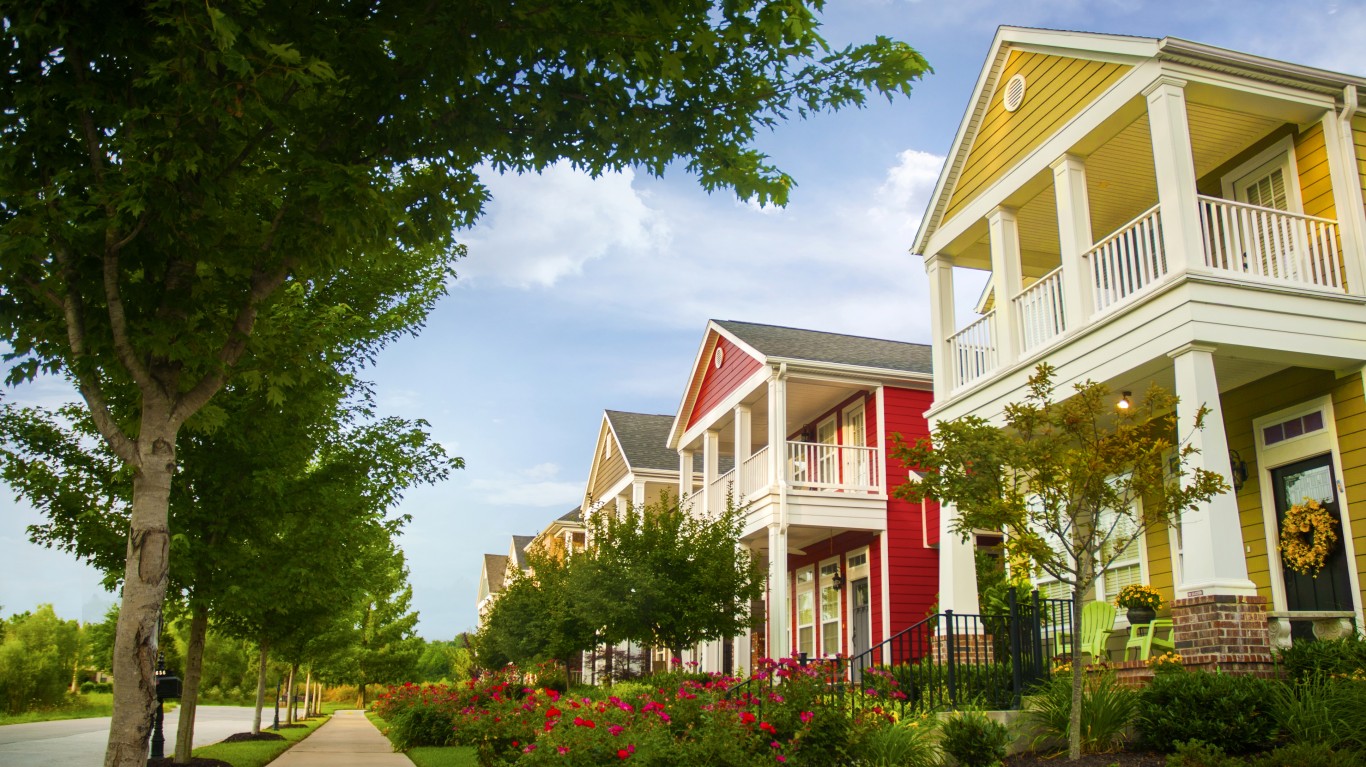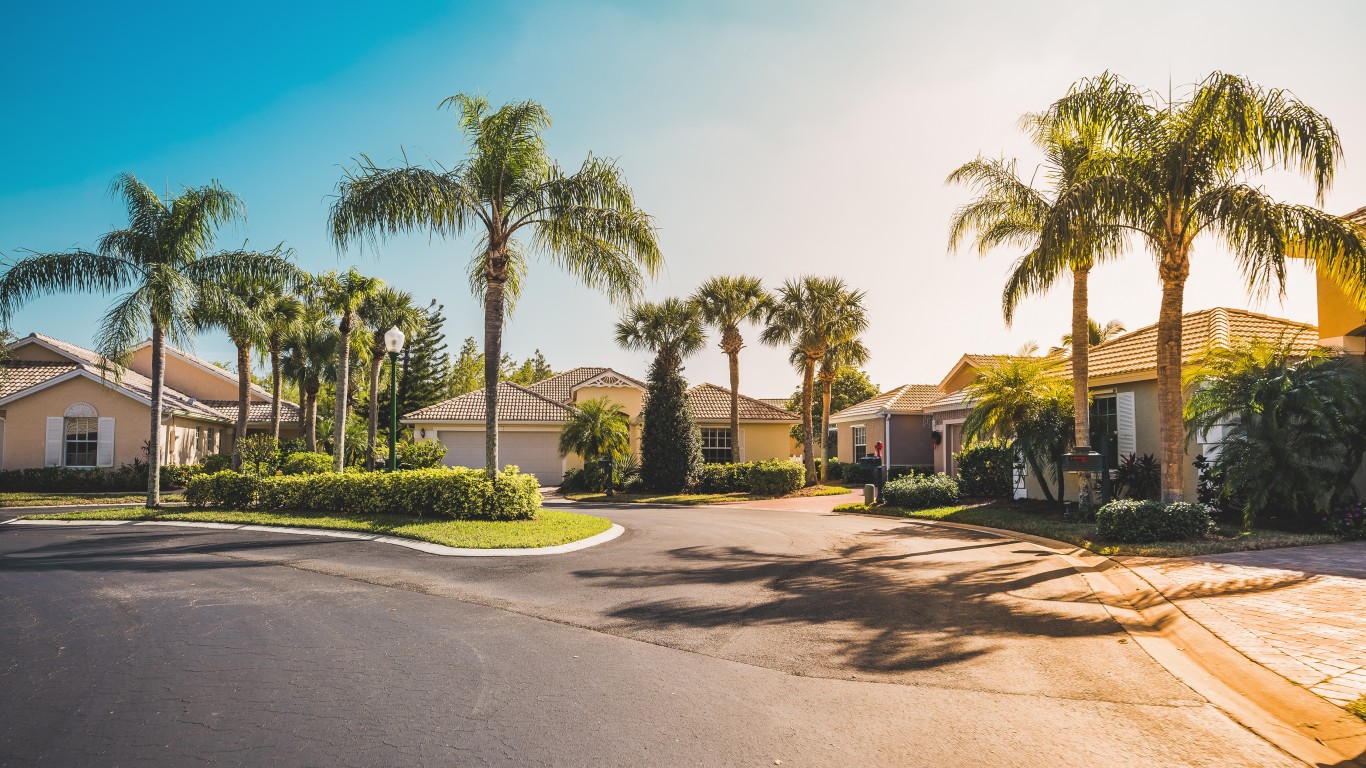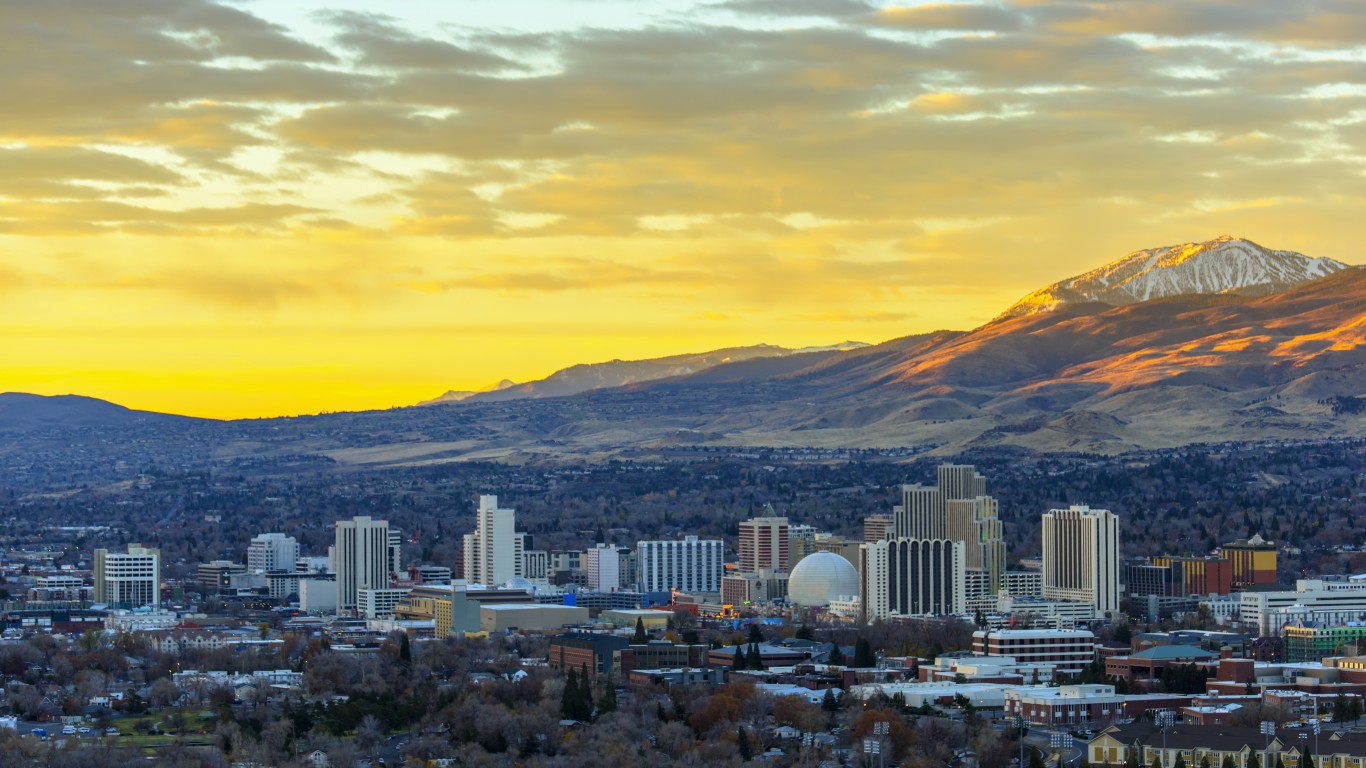Special Report
What Income Level Is Considered Middle Class in Your State?

Published:
Last Updated:

Median household income numbers offer a good measure of how American families are faring economically — and for the first time in years, many U.S. households saw a drop in earnings, based on recently released official statistics.
In 2020, U.S. national median household income fell by 2.9% compared to the previous year, from $69,560 to $67.521. The U.S. Census Bureau reported that this was the first “statistically significant” drop since 2011. (Here is a list of states where income inequality has gotten worse since 2010.)
Unlike average income, the median income number captures the true “middle.” The government has no official definition of what constitutes a middle-class income, but a common measure, established by Pew Research Center), considers a household to be “middle class” if its income resides anywhere between two-thirds and twice the median household income, depending on factors like size of household and local costs of living. (These, though, are cities where the middle class can no longer afford housing.)
Click here to learn what income level is considered middle class in your state
Last year’s decline in median household incomes came thanks to the pandemic, which decimated jobs in the retail and hospitality industries. More than 9.4 million jobs were lost last year, and as of September 2021, the U.S. remains nearly 4.4 million jobs shy of full recovery.
This year-over-year decline affected various regions of the U.S. differently. The Midwest was hit the hardest, with a 3.2% decline from 2020, while median incomes in the Northeast were not significantly impacted. The South and the West each experienced a 2.3% drop.
To determine the income it takes for a family to be considered middle class in every state, 24/7 Wall St. reviewed data on U.S. household income quintiles from the U.S. Census Bureau’s 2019 American Community Survey. The lower and upper boundaries of the three middle income quintiles for the U.S. as a whole were adjusted for state-level cost of living using regional price parity (RPP) data for 2019 from the Bureau of Economic Analysis.
The RPP-adjusted boundaries were defined as the range of income that could be considered middle class in a given state. Data on median family income, the share of income held by the middle class, and the share of income held by the wealthiest 5% of households came from U.S. Census Bureau’s 2019 American Community Survey.

Alabama
> Income needed to be considered middle class: $23,242 – $112,697
> Median family income: $66,171 (6th lowest)
> Share of income held by “middle class”: 46.5% (22nd lowest)
> Share of income held by wealthiest 5% of households: 21.8% (23rd lowest)
> Cost of living in Alabama: 14.2% less expensive than U.S. avg.
[in-text-ad]

Alaska
> Income needed to be considered middle class: $28,469 – $138,048
> Median family income: $91,971 (11th highest)
> Share of income held by “middle class”: 48.7% (4th highest)
> Share of income held by wealthiest 5% of households: 19.7% (the lowest)
> Cost of living in Alaska: 5.1% more expensive than U.S. avg.

Arizona
> Income needed to be considered middle class: $26,086 – $126,489
> Median family income: $74,468 (17th lowest)
> Share of income held by “middle class”: 46.8% (24th highest)
> Share of income held by wealthiest 5% of households: 21.8% (23rd lowest)
> Cost of living in Arizona: 3.7% less expensive than U.S. avg.

Arkansas
> Income needed to be considered middle class: $22,944 – $111,253
> Median family income: $62,387 (4th lowest)
> Share of income held by “middle class”: 45.6% (9th lowest)
> Share of income held by wealthiest 5% of households: 23.1% (13th highest)
> Cost of living in Arkansas: 15.3% less expensive than U.S. avg.
[in-text-ad-2]

California
> Income needed to be considered middle class: $31,530 – $152,890
> Median family income: $91,377 (12th highest)
> Share of income held by “middle class”: 45.0% (5th lowest)
> Share of income held by wealthiest 5% of households: 23.4% (7th highest)
> Cost of living in California: 16.4% more expensive than U.S. avg.

Colorado
> Income needed to be considered middle class: $27,603 – $133,845
> Median family income: $95,164 (7th highest)
> Share of income held by “middle class”: 47.2% (21st highest)
> Share of income held by wealthiest 5% of households: 21.8% (21st lowest)
> Cost of living in Colorado: 1.9% more expensive than U.S. avg.
[in-text-ad]

Connecticut
> Income needed to be considered middle class: $28,442 – $137,916
> Median family income: $101,272 (4th highest)
> Share of income held by “middle class”: 43.8% (2nd lowest)
> Share of income held by wealthiest 5% of households: 25.3% (2nd highest)
> Cost of living in Connecticut: 5.0% more expensive than U.S. avg.

Delaware
> Income needed to be considered middle class: $26,925 – $130,561
> Median family income: $87,148 (16th highest)
> Share of income held by “middle class”: 47.9% (13th highest)
> Share of income held by wealthiest 5% of households: 21.0% (14th lowest)
> Cost of living in Delaware: 0.6% less expensive than U.S. avg.

Florida
> Income needed to be considered middle class: $27,359 – $132,662
> Median family income: $71,348 (11th lowest)
> Share of income held by “middle class”: 44.8% (3rd lowest)
> Share of income held by wealthiest 5% of households: 24.1% (3rd highest)
> Cost of living in Florida: 1.0% more expensive than U.S. avg.
[in-text-ad-2]

Georgia
> Income needed to be considered middle class: $25,246 – $122,417
> Median family income: $74,833 (18th lowest)
> Share of income held by “middle class”: 45.4% (7th lowest)
> Share of income held by wealthiest 5% of households: 23.3% (9th highest)
> Cost of living in Georgia: 6.8% less expensive than U.S. avg.

Hawaii
> Income needed to be considered middle class: $32,316 – $156,699
> Median family income: $96,462 (6th highest)
> Share of income held by “middle class”: 49.0% (2nd highest)
> Share of income held by wealthiest 5% of households: 19.9% (2nd lowest)
> Cost of living in Hawaii: 19.3% more expensive than U.S. avg.
[in-text-ad]

Idaho
> Income needed to be considered middle class: $24,975 – $121,104
> Median family income: $72,365 (13th lowest)
> Share of income held by “middle class”: 48.3% (7th highest)
> Share of income held by wealthiest 5% of households: 20.6% (6th lowest)
> Cost of living in Idaho: 7.8% less expensive than U.S. avg.

Illinois
> Income needed to be considered middle class: $26,384 – $127,934
> Median family income: $87,771 (15th highest)
> Share of income held by “middle class”: 45.7% (11th lowest)
> Share of income held by wealthiest 5% of households: 23.1% (11th highest)
> Cost of living in Illinois: 2.6% less expensive than U.S. avg.

Indiana
> Income needed to be considered middle class: $24,027 – $116,507
> Median family income: $73,876 (16th lowest)
> Share of income held by “middle class”: 46.9% (23rd highest)
> Share of income held by wealthiest 5% of households: 22.3% (21st highest)
> Cost of living in Indiana: 11.3% less expensive than U.S. avg.
[in-text-ad-2]

Iowa
> Income needed to be considered middle class: $24,108 – $116,901
> Median family income: $78,152 (25th lowest)
> Share of income held by “middle class”: 48.1% (10th highest)
> Share of income held by wealthiest 5% of households: 21.1% (16th lowest)
> Cost of living in Iowa: 11.0% less expensive than U.S. avg.

Kansas
> Income needed to be considered middle class: $24,162 – $117,163
> Median family income: $79,006 (25th highest)
> Share of income held by “middle class”: 47.5% (17th highest)
> Share of income held by wealthiest 5% of households: 21.3% (18th lowest)
> Cost of living in Kansas: 10.8% less expensive than U.S. avg.
[in-text-ad]

Kentucky
> Income needed to be considered middle class: $23,675 – $114,799
> Median family income: $66,183 (7th lowest)
> Share of income held by “middle class”: 46.0% (17th lowest)
> Share of income held by wealthiest 5% of households: 23.1% (11th highest)
> Cost of living in Kentucky: 12.6% less expensive than U.S. avg.

Louisiana
> Income needed to be considered middle class: $23,810 – $115,456
> Median family income: $65,105 (5th lowest)
> Share of income held by “middle class”: 45.1% (6th lowest)
> Share of income held by wealthiest 5% of households: 23.2% (10th highest)
> Cost of living in Louisiana: 12.1% less expensive than U.S. avg.

Maine
> Income needed to be considered middle class: $26,898 – $130,430
> Median family income: $76,316 (22nd lowest)
> Share of income held by “middle class”: 47.6% (16th highest)
> Share of income held by wealthiest 5% of households: 20.9% (11th lowest)
> Cost of living in Maine: 0.7% less expensive than U.S. avg.
[in-text-ad-2]

Maryland
> Income needed to be considered middle class: $29,174 – $141,463
> Median family income: $105,679 (3rd highest)
> Share of income held by “middle class”: 47.6% (15th highest)
> Share of income held by wealthiest 5% of households: 21.0% (15th lowest)
> Cost of living in Maryland: 7.7% more expensive than U.S. avg.

Massachusetts
> Income needed to be considered middle class: $29,905 – $145,009
> Median family income: $108,348 (the highest)
> Share of income held by “middle class”: 46.3% (21st lowest)
> Share of income held by wealthiest 5% of households: 22.4% (20th highest)
> Cost of living in Massachusetts: 10.4% more expensive than U.S. avg.
[in-text-ad]

Michigan
> Income needed to be considered middle class: $25,002 – $121,235
> Median family income: $75,703 (20th lowest)
> Share of income held by “middle class”: 46.5% (24th lowest)
> Share of income held by wealthiest 5% of households: 22.1% (24th highest)
> Cost of living in Michigan: 7.7% less expensive than U.S. avg.

Minnesota
> Income needed to be considered middle class: $26,546 – $128,722
> Median family income: $93,584 (9th highest)
> Share of income held by “middle class”: 48.0% (11th highest)
> Share of income held by wealthiest 5% of households: 21.0% (13th lowest)
> Cost of living in Minnesota: 2.0% less expensive than U.S. avg.

Mississippi
> Income needed to be considered middle class: $22,862 – $110,859
> Median family income: $58,503 (the lowest)
> Share of income held by “middle class”: 45.0% (4th lowest)
> Share of income held by wealthiest 5% of households: 23.4% (6th highest)
> Cost of living in Mississippi: 15.6% less expensive than U.S. avg.
[in-text-ad-2]
Missouri
> Income needed to be considered middle class: $24,027 – $116,507
> Median family income: $73,457 (15th lowest)
> Share of income held by “middle class”: 46.7% (25th lowest)
> Share of income held by wealthiest 5% of households: 22.2% (23rd highest)
> Cost of living in Missouri: 11.3% less expensive than U.S. avg.

Montana
> Income needed to be considered middle class: $25,327 – $122,811
> Median family income: $73,014 (14th lowest)
> Share of income held by “middle class”: 46.8% (25th highest)
> Share of income held by wealthiest 5% of households: 22.7% (18th highest)
> Cost of living in Montana: 6.5% less expensive than U.S. avg.
[in-text-ad]

Nebraska
> Income needed to be considered middle class: $24,244 – $117,557
> Median family income: $80,062 (23rd highest)
> Share of income held by “middle class”: 48.2% (9th highest)
> Share of income held by wealthiest 5% of households: 20.8% (9th lowest)
> Cost of living in Nebraska: 10.5% less expensive than U.S. avg.

Nevada
> Income needed to be considered middle class: $26,384 – $127,934
> Median family income: $76,124 (21st lowest)
> Share of income held by “middle class”: 46.0% (18th lowest)
> Share of income held by wealthiest 5% of households: 23.9% (4th highest)
> Cost of living in Nevada: 2.6% less expensive than U.S. avg.

New Hampshire
> Income needed to be considered middle class: $28,849 – $139,887
> Median family income: $97,112 (5th highest)
> Share of income held by “middle class”: 48.3% (8th highest)
> Share of income held by wealthiest 5% of households: 20.4% (4th lowest)
> Cost of living in New Hampshire: 6.5% more expensive than U.S. avg.
[in-text-ad-2]

New Jersey
> Income needed to be considered middle class: $31,422 – $152,365
> Median family income: $105,705 (2nd highest)
> Share of income held by “middle class”: 45.8% (13th lowest)
> Share of income held by wealthiest 5% of households: 22.6% (19th highest)
> Cost of living in New Jersey: 16.0% more expensive than U.S. avg.

New Mexico
> Income needed to be considered middle class: $24,677 – $119,659
> Median family income: $61,826 (3rd lowest)
> Share of income held by “middle class”: 46.1% (19th lowest)
> Share of income held by wealthiest 5% of households: 22.0% (25th highest)
> Cost of living in New Mexico: 8.9% less expensive than U.S. avg.
[in-text-ad]

New York
> Income needed to be considered middle class: $31,503 – $152,759
> Median family income: $89,475 (13th highest)
> Share of income held by “middle class”: 43.1% (the lowest)
> Share of income held by wealthiest 5% of households: 25.8% (the highest)
> Cost of living in New York: 16.3% more expensive than U.S. avg.

North Carolina
> Income needed to be considered middle class: $24,840 – $120,447
> Median family income: $72,049 (12th lowest)
> Share of income held by “middle class”: 45.7% (10th lowest)
> Share of income held by wealthiest 5% of households: 22.9% (15th highest)
> Cost of living in North Carolina: 8.3% less expensive than U.S. avg.

North Dakota
> Income needed to be considered middle class: $24,190 – $117,295
> Median family income: $87,055 (17th highest)
> Share of income held by “middle class”: 47.4% (18th highest)
> Share of income held by wealthiest 5% of households: 21.8% (24th lowest)
> Cost of living in North Dakota: 10.7% less expensive than U.S. avg.
[in-text-ad-2]
Ohio
> Income needed to be considered middle class: $23,946 – $116,113
> Median family income: $74,911 (19th lowest)
> Share of income held by “middle class”: 46.5% (23rd lowest)
> Share of income held by wealthiest 5% of households: 22.3% (22nd highest)
> Cost of living in Ohio: 11.6% less expensive than U.S. avg.

Oklahoma
> Income needed to be considered middle class: $23,621 – $114,536
> Median family income: $68,358 (8th lowest)
> Share of income held by “middle class”: 45.8% (15th lowest)
> Share of income held by wealthiest 5% of households: 23.3% (8th highest)
> Cost of living in Oklahoma: 12.8% less expensive than U.S. avg.
[in-text-ad]

Oregon
> Income needed to be considered middle class: $27,684 – $134,239
> Median family income: $82,540 (20th highest)
> Share of income held by “middle class”: 47.9% (14th highest)
> Share of income held by wealthiest 5% of households: 20.7% (7th lowest)
> Cost of living in Oregon: 2.2% more expensive than U.S. avg.

Pennsylvania
> Income needed to be considered middle class: $26,275 – $127,409
> Median family income: $81,075 (22nd highest)
> Share of income held by “middle class”: 45.8% (14th lowest)
> Share of income held by wealthiest 5% of households: 23.0% (14th highest)
> Cost of living in Pennsylvania: 3.0% less expensive than U.S. avg.

Rhode Island
> Income needed to be considered middle class: $27,440 – $133,057
> Median family income: $89,373 (14th highest)
> Share of income held by “middle class”: 47.3% (19th highest)
> Share of income held by wealthiest 5% of households: 22.0% (25th lowest)
> Cost of living in Rhode Island: 1.3% more expensive than U.S. avg.
[in-text-ad-2]

South Carolina
> Income needed to be considered middle class: $24,786 – $120,184
> Median family income: $70,537 (10th lowest)
> Share of income held by “middle class”: 46.0% (16th lowest)
> Share of income held by wealthiest 5% of households: 22.7% (17th highest)
> Cost of living in South Carolina: 8.5% less expensive than U.S. avg.

South Dakota
> Income needed to be considered middle class: $23,783 – $115,324
> Median family income: $76,826 (24th lowest)
> Share of income held by “middle class”: 48.4% (5th highest)
> Share of income held by wealthiest 5% of households: 20.4% (5th lowest)
> Cost of living in South Dakota: 12.2% less expensive than U.S. avg.
[in-text-ad]

Tennessee
> Income needed to be considered middle class: $24,298 – $117,820
> Median family income: $69,993 (9th lowest)
> Share of income held by “middle class”: 45.5% (8th lowest)
> Share of income held by wealthiest 5% of households: 23.5% (5th highest)
> Cost of living in Tennessee: 10.3% less expensive than U.S. avg.

Texas
> Income needed to be considered middle class: $26,140 – $126,752
> Median family income: $76,727 (23rd lowest)
> Share of income held by “middle class”: 45.7% (12th lowest)
> Share of income held by wealthiest 5% of households: 22.8% (16th highest)
> Cost of living in Texas: 3.5% less expensive than U.S. avg.

Utah
> Income needed to be considered middle class: $26,140 – $126,752
> Median family income: $86,152 (18th highest)
> Share of income held by “middle class”: 48.7% (3rd highest)
> Share of income held by wealthiest 5% of households: 20.9% (12th lowest)
> Cost of living in Utah: 3.5% less expensive than U.S. avg.
[in-text-ad-2]

Vermont
> Income needed to be considered middle class: $27,928 – $135,421
> Median family income: $83,458 (19th highest)
> Share of income held by “middle class”: 48.0% (12th highest)
> Share of income held by wealthiest 5% of households: 20.7% (8th lowest)
> Cost of living in Vermont: 3.1% more expensive than U.S. avg.

Virginia
> Income needed to be considered middle class: $27,440 – $133,057
> Median family income: $93,497 (10th highest)
> Share of income held by “middle class”: 46.3% (21st lowest)
> Share of income held by wealthiest 5% of households: 21.7% (20th lowest)
> Cost of living in Virginia: 1.3% more expensive than U.S. avg.
[in-text-ad]

Washington
> Income needed to be considered middle class: $29,363 – $142,382
> Median family income: $94,709 (8th highest)
> Share of income held by “middle class”: 46.9% (22nd highest)
> Share of income held by wealthiest 5% of households: 21.6% (19th lowest)
> Cost of living in Washington: 8.4% more expensive than U.S. avg.

West Virginia
> Income needed to be considered middle class: $23,594 – $114,405
> Median family income: $60,920 (2nd lowest)
> Share of income held by “middle class”: 47.2% (20th highest)
> Share of income held by wealthiest 5% of households: 21.3% (17th lowest)
> Cost of living in West Virginia: 12.9% less expensive than U.S. avg.

Wisconsin
> Income needed to be considered middle class: $24,894 – $120,710
> Median family income: $81,829 (21st highest)
> Share of income held by “middle class”: 48.4% (6th highest)
> Share of income held by wealthiest 5% of households: 20.8% (10th lowest)
> Cost of living in Wisconsin: 8.1% less expensive than U.S. avg.
[in-text-ad-2]

Wyoming
> Income needed to be considered middle class: $25,138 – $121,892
> Median family income: $79,946 (24th highest)
> Share of income held by “middle class”: 49.1% (the highest)
> Share of income held by wealthiest 5% of households: 20.4% (4th lowest)
> Cost of living in Wyoming: 7.2% less expensive than U.S. avg.
The thought of burdening your family with a financial disaster is most Americans’ nightmare. However, recent studies show that over 100 million Americans still don’t have proper life insurance in the event they pass away.
Life insurance can bring peace of mind – ensuring your loved ones are safeguarded against unforeseen expenses and debts. With premiums often lower than expected and a variety of plans tailored to different life stages and health conditions, securing a policy is more accessible than ever.
A quick, no-obligation quote can provide valuable insight into what’s available and what might best suit your family’s needs. Life insurance is a simple step you can take today to help secure peace of mind for your loved ones tomorrow.
Click here to learn how to get a quote in just a few minutes.
Thank you for reading! Have some feedback for us?
Contact the 24/7 Wall St. editorial team.